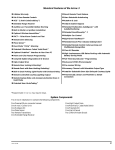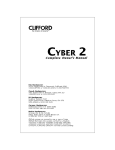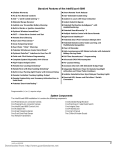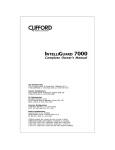Download Clifford GP500 User`s manual
Transcript
Maintenance Your GP500 system requires no maintenance except for replacement of remote control batteries when they reach the end of their useful life. For further information on this, see the Automatic low battery warning and Remote control battery replacement sections on page 13. This product, like any electrical device on your motorcycle, requires that your motorcycle battery be in proper working order and fully charged. To ensure proper operation, periodically have your motorcycle battery “load-checked” at any local garage/mechanic and ask them to verify that the charging system is working properly. Also make sure that the battery cables and connections are tight and free from corrosion. User’s Manual/299 1 Welcome to the world of high-technology C vehicle security and convenience ongratulations on the purchase of your GP500 motorcycle security/convenience system. Your remote controls The weather resistant pair of remote controls that are provided with GP500 are ultra-sophisticated miniature radio transmitters powered by a single miniature battery (a 3-volt lithium). 2 GP500 Remotely controlling your GP500 Each of your two remote controls can command several different functions. TO ARM: Press button I on the remote control. You will hear two chirps and the indicator lights will flash twice. The LED will flash repeatedly. TO DISARM: Press button I on the remote control. One chirp and one indicator light flash confirms disarming and the LED turns off. TO ARM OR DISARM SILENTLY: By pressing button II on the remote control, you can arm or disarm your GP500 with all the indications previously noted except the chirps. TO ACTIVATE THE BIKE BEACON LOCATOR: For three seconds, continually press button I on the remote control. The indicator lights will flash repeatedly and the siren will blare until you press the button again to turn it off. User’s Manual/299 3 TO ACTIVATE INSTANT AUTOARMING BYPASS: Press button III on the remote control and hold for three seconds. Two indicator light flashes confirm that GP500 will NOT AutoArm. If you press and hold button III for three seconds once more, the system will respond with one indicator light flash which means that AutoArming has been reactivated. The next time the motorcyle is parked, the GP500 system resumes normal AutoArming operations. OTHER FEATURES Other features can be accessed as noted in the following chart: 4 GP500 QUICK REFERENCE: REMOTE CONTROL FUNCTIONS Function Press button(s) Arm or disarm I Silently arm or disarm II Instant AutoArming Bypass (press and hold button for three seconds while system is disarmed) III Dual-Level Piezo Sensor Warning Level Bypass (press button within 10 seconds after arming the system) III Dual-Level Piezo Sensor Total Bypass (press and hold button for three seconds within 10 seconds after arming the system) III Digital Tilt/Motion Sensor Warning Zone Bypass (press buttons within 10 seconds after system is armed) II + III Digital Tilt/Motion Sensor Total Bypass (press and hold buttons for three seconds within 10 seconds after system is armed) II + III Dual-Level Piezo Sensor Adjustment (press and hold buttons for three seconds while system is disarmed. See page 21 for complete instructions) II + III Unassigned* I + II Unassigned* I + III * Can be assigned to Clifford ACG-2 systems on your other vehicles. User’s Manual/299 5 ACG-2™ (Anti-CodeGrabbing 2™) Clifford’s ACG-2 protects your motorcycle from thieves’ remote control “cloning” devices that are used to record the disarming code transmitted from your remote. Automatic remote control low-battery warning If your remote control battery is very low, you will hear five rapid chirps when you disarm rather than the single chirp that you normally hear. Remote control battery replacement Any Authorized Clifford Dealer will be happy to replace a remote control battery for you without cost provided you purchase the replacement battery at their shop (it’s also a good idea to keep a spare battery on-hand just in case). 1. Insert a small, thin screwdriver blade in the slot near the keyring opening (you may leave the keyring in place) and turn it to separate the two halves. 2. Remove the old battery noting the + and – indications and replace it. 3. Put the enclosure back together by first aligning the top of the remote, then snapping the case back together at the bottom. 6 GP500 Two-Point Internal Immobilisation Please be aware that the AutoArming feature has no effect on Immobilisation. The system automatically immobilizes your vehicle’s starter and ignition 30 seconds after engine shutdown or when you arm with the remote control. When you remotely disarm your GP500 system, the Immobilisation circuits will automatically disengage. You then have 30 seconds in which to start the engine (or turn the ignition switch to its “ON” position). If more than 30 seconds pass, the immobilizer will automatically reactivate. This will be visually indicated by the LED repeatedly flashing, but at a slower rate than that of the normal rapid “armed” indication flash rate. To disarm the Immobilizer if it has armed itself, use the remote control to arm and then disarm the system, or turn on the ignition and press button I on the remote control. User’s Manual/299 7 AutoArming™ If this feature is enabled and you forget to remotely arm. After 30 seconds pass, the system is automatically armed. In instances where you want to bypass AutoArming, such as when fueling the motorcycle, simply turn the ignition on and then off again after you have parked. Digital Dual-Zone Tilt/Motion Sensor Clifford’s Digital Tilt/Motion Sensor detects one degree of tilting or any minute forward/reverse motion of the motorcycle while completely ignoring all other conditions that falsely set off other sensors. Even if you park your motorcycle on the steepest hill, it will accurately respond to the first hint of tampering. The Digital/Tilt Motion Sensor will first provide a five chirp warning if the motorcycle tilts more than one degree. Once the motorcycle tilts more than two degrees, the full alarm will sound. TO REMOTELY BYPASS THE WARNING ZONE: 8 During the first 10 seconds after arming the system remotely, simultaneously press buttons II and III on the remote control. The system provides four indicator light flashes when the warning zone is bypassed. GP500 TO REMOTELY BYPASS BOTH ZONES: During the first 10 seconds after arming the system remotely, simultaneously press buttons II and III on the remote control and hold for three seconds. The system provides four indicator light flashes to indicate when the warning zone is bypassed, and another four indicator light flashes when both zones are bypassed. Fully Adjustable Dual-Level Piezo Sensor The Dual-Level Piezo Sensor detects vibration and impacts to the motorcycle. If someone were to lean on or sit on the motorcycle, the primary zone of this sensor would trigger the full alarm. However, if a thief lightly bumped the motorcycle, a four chirp warning would sound. User’s Manual/299 9 TO REMOTELY ADJUST THE DUAL-ZONE PIEZO SENSOR: 10 With the ignition turned OFF. Press buttons II and III simultaneously for three seconds. The system will respond with one chirp. To adjust the warning level of the sensor, you must have the ignition turned ON, to adjust the trigger level of the sensor, turn the ignition OFF. Then: • Press button II to decrease sensitivity. A single chirp confirms each decrease in sensitivity. • Press button III to increase sensitivity. Two chirps confirm each increase in sensitivity. • Three chirps indicate that you are at the top or bottom of the 16 step incremental range. Test your settings by lightly thumping on the motorcycle. One chirp signals an alarm trigger level detection, two chirps signal a warning level detection. Press button I on the remote control to save the new settings. GP500 TO REMOTELY BYPASS THE WARNING ZONE: During the first 10 seconds after arming the system remotely, press button III on the remote control. The system provides four indicator light flashes when the warning level is bypassed. TO REMOTELY BYPASS BOTH ZONES: During the first 10 seconds after arming the system remotely, press button III on the remote control and hold for three seconds. The system provides four indicator light flashes to indicate when the warning level is bypassed, and another four indicator light flashes when both levels are bypassed. Helmet Theft Protection System Loop the helmet theft prevention wire through the item to be secured. Connect the hook at the end of the loop under the seat. Close the seat making sure it is firmly latched and arm the system. User’s Manual/299 11 False Alarm Prevention & FACT™ With Clifford’s patented FACT (False Alarm Control and Test) feature, you’ll never experience repeated false alarms. If the siren sounds, DO NOT remotely disarm the system; allow it to run for the full 30-second siren duration. Before sounding the siren a second time, the system automatically checks for another activated sensor or trigger. Should the siren sound again, you will know for sure that someone is tampering with your motorcycle. (If you wish, you may turn off FACT, see the Table of Programmable features on page 32.) How to interpret the chirps and flashes Chirps/flashes 12 Meaning 1 You have disarmed the system 2 You have armed the system 3 Disarmed but there was an intrusion attempt while you were away (see Smart prior intrusion attempt on the following page) 4 Armed but the Helmet Theft Prevention system or sensor has malfunctioned and has been bypassed (see Smart Autotesting below). GP500 How to interpret the LED status indicator LED Condition Off Meaning System is disarmed Flashing Steadily (Ignition off) System is armed Flashing rapidly (ignition off) AutoArming Countdown Flashing slowly (ignition on or off) System is disarmed but Immobilisation points are engaged (see page 15) Pause between slow Either a malfunction (see Smart AutoTesting below) or flashes (ignition on) an intrusion was attempted (see Smart prior intrusion attempt alert on page 27) Automatic Battery-Saving Mode To conserve motorcycle battery power (the LED draws more current than the entire control unit), if the system has remained continuously armed for 24 hours, the flash rate will automatically slow to half the normal rate. User’s Manual/299 13 Smart AutoTesting™ Each time you remotely arm the system, it tests all triggers and sensors. For example, if the Helmet Theft Prevention System is active, you will receive the usual 2 chirps and flashes, then, 5 seconds later, there will be 4 chirps and 4 flashes. If a sensor is malfunctioning, you will receive the usual 2 chirps and 2 flashes, then, 10 seconds later, there will be 4 chirps and 4 flashes. Note that when you receive these indications that the system will still arm even though a trigger or sensor is malfunctioning. NOTE: Since this is a warning indication, you will hear the 4 chirps even if you use the chirp muting feature. n Specific malfunction identification: The system can also indicate the specific trigger or sensor that is malfunctioning. If you get the 4-chirp/4-flash signal upon arming, perform the following to identify the malfunctioning trigger or sensor: 1. Remotely disarm, then turn on the ignition. The LED status indicator will be flashing, pause, then repeat. 2. Count the number of flashes in one cycle between pauses (for your convenience, the flash cycle repeats a total of 5 times) and refer to the following chart: 14 GP500 LED flashes 1 flash Meaning Ignition switch was turned on 2 flashes Activation of Digital Tilt/Motion Sensor 3 flashes Activation of Dual-Level Piezo Sensor 4 flashes Activation of helmet theft prevention device 5 flashes Optional additional trigger was activated (such as a seat trigger) 6 flashes Activation of Panic Feature/Remote Vehicle Locator 7 flashes Three or more incorrect PIN codes were entered via the PlainView 2 switch 8 flashes Low remote control battery Automatic malfunction bypass with AutoReMonitoring™ Even if a system component malfunctions, the system will automatically bypass any faulty point and arm all other triggers and sensors to protect the vehicle until you can have the system serviced by your local Authorized Clifford Dealer. User’s Manual/299 15 Smart prior intrusion attempt alert If you hear three chirps when you remotely disarm, it means that a trigger or sensor was activated in your absence. When you turn on the ignition (or start the engine), the LED will flash 1-8 times, pause, then repeat the flash cycle 4 more times. Count the number of flashes in one cycle and refer to the chart on the previous page. Eight-Event TotalRecall™ Your GP500 system’s memory records the identity of the last eight activated or malfunctioning triggers and sensors in reverse chronological order, which allows your installer to instantly track down malfunctions. 1. Remotely arm and disarm while pressing and holding the unmarked button on the PlainView 2 switch. 2. The LED will flash 1-8 times to indicate the most recently activated point, pause, flash 1-8 times to indicate the second most recently activated point, and so on. 3. Write down the number of flashes between pauses and refer to the chart on the previous page. 16 GP500 SmartPowerUp™ 2 If power to the system is ever removed, SmartPowerUp 2 ensures that your GP500 system automatically restores itself to its previous state when power is restored. So if a thief disconnects the power and then restores it in an attempt to start the motorcycle, the system will re-arm and instantly sound the siren while immobilising the motorcycle. If your motorcycle is to be serviced, just use the siren shutoff key to bypass the siren’s circuitry. Self-Powered Siren This siren has its own built-in back-up battery, so even if a thief cuts all the wires, the siren will continue to wail. You may use the supplied keys to turn off the siren for servicing. PlainView 2 Programming Switch You can easily change the status of GP500’s numerous features at any time, even while the engine is running. The programming mode of Clifford systems require the entry of a secret PIN code The factory preset PIN code is “2.” User’s Manual/299 17 How to enter your PIN Code for the first time The PIN code provides two functions: to turn the alarm off in the event that you cannot use your remote control and secondly, to access programming mode. Your GP500 PIN code was set by the factory. You may want to change the PIN code using the instructions provided to insure the utmost vehicle security. EXAMPLE: To enter the factory preset Pin code of 2, you would press and release the PlainView 2 switch buttons thusly: ✱✱ marked, unmarked. How to set your PIN code You may choose any 1-, 2-, 3- or 4-digit code, but the first digit must not be a zero (e.g., 1023 is a valid code, 0123 would not be a valid code). NOTE: You may NOT select a code that begins with a zero. The first digit of your code must be 1–9. Example To set a disarming code of 4301, you would do the following: 1. Enter program mode by turning on the ignition, entering your current PIN code, then pressing and holding the PlainView 2 ✱ button for 3 seconds until you hear a chirp. 18 GP500 2. Within 5 seconds, press and release the PlainView 2 ✱ button 7 times. To help you count, you will hear a chirp each time you press the ✱ button. After 7 presses, wait for a single chirp, then immediately enter your new PIN code. Example: To enter 4301 as your new code, you would press the switch buttons in this manner: ✱✱✱✱ blank side, ✱✱✱ blank side, blank side, ✱ blank side. 3. Pause and wait for the 3-chirp confirmation. 4. Turn off the ignition to exit program mode (you’ll hear a 3-chirp confirmation). 5. VERY IMPORTANT: You must immediately test your new PIN code. Turn on the ignition, enter your new code, then press and hold the unmarked button for 3 seconds. The LED will illuminate to indicate the proper code change. Programmable features GP500 lets you set many of its features to your own preferences. Once you’ve changed a few settings, you’ll find that programming GP500 is fast and easy! The system features are preprogrammed as noted by the bold type in the Table of programmable features beginning on pages 32. To change any of the settings, use the steps noted below. To restore the feature to its factory setting, just repeat the procedure. User’s Manual/299 19 Step-by-step programming instructions 1. Refer to the Table of programmable features on page 32 and find the feature you wish to program. Make note of the number of times to press the ✱ button. 2. Turn the ignition on, or start the engine (skip this step if the engine is running). 3. Enter your PIN code, then press and hold the ✱ button of the PlainView 2 switch for about 3 seconds until you hear a siren chirp. Release the button. You are now in Program mode. 4. Press and release the ✱ button of the PlainView 2 switch the number of times indicated for the feature you are programming. You will hear one chirp each time you press the ✱ button. Pause. You will hear a succession of chirps equal to the number of times you pressed the ✱ button. This audibly confirms your selection. 5. Perform the action, if any, in the “Secondary action” column. 6. Pause. You will hear either one or two chirps: Two chirps=ON, one chirp=OFF (If there is a NOTE for the selected feature, perform the actions noted). 7. You may now select another feature or exit program mode: If you make an error, just turn off the ignition and start again. 20 GP500 Table of Programmable Features Factory Setting No. of times to press the ✱ button Secondary Action Program completion confirmation Additional Action AutoArming OFF 2 - 1 chirp=OFF 2 chirps=ON - Chirps ON 3 - 1 chirp=ON 2 chirps=OFF - FACT ON 4 - 1 chirp=OFF 2 chirps=ON - Feature Change PIN code See back cover of this manual for factory preset PIN code Auto Program New GP500 Remote See page 12 for standard settings User’s Manual/299 7 Enter new PIN code. Wait. Enter new 1 chirp=new PIN code PIN code is again, system accepted provides 2 chirps. 9 Press remote control button I Press 1 chirp=all button I buttons are again, programmed system provides 2 chirps. 21 Feature Program other Clifford ACG-2 Remote to Arm/Disarm GP500 Program other Clifford ACG-2 Remote to Silent Arm GP500 Program other Clifford ACG-2 Remote to Bypass Instant AutoArming for GP500 22 Factory Setting - - - No. of times to press the ✱ button Secondary Action Program completion confirmation Additional Action 10 Press remote control button to be assigned to this function 1 chirp= button is ready to be assigned to the function Press button to be assigned again. System provides 2 chirps. 11 Press remote control button to be assigned to this function 2 chirps= button is ready to be assigned to the function Press button to be assigned again. System provides 2 chirps. 12 Press button to be assigned to this function 3 chirps= button is ready to be assigned to the function Press button to be assigned again. System provides 2 chirps. GP500 Feature Factory Setting No. of times to press the ✱ button Secondary Action Program other Clifford ACG-2 Remote to Adjust Piezo Sensor for GP500 - 13 Press button to be assigned to this function Clear All Remotes Two remotes in system memory 15 - User’s Manual/299 Program completion confirmation Additional Action 4 chirps= button is ready to be assigned to the function Press remote control button to be assigned again. System provides 2 chirps. 3 chirps= all remotes are cleared from system memory Reprogra m remotes as required. 23 24 GP500 Your serial number is: Paste serial number sticker here REGISTER ONLINE: Within 10 days of purchase, you may register your Clifford purchase online at www.clifford.com/manuals so that we can contact you in the future if there are any changes or improvements to your GP500 system. Or just photocopy this page, note your name, address and vehicle make, model, year and VIN number, then mail to us at the address on the previous page. THANKS! Owner’s Manual/299 25 USA Headquarters: Clifford Electronics, Inc. 20750 Lassen Street, Chatsworth, CA 91311 Within USA: 1-800-824-3208 Phone: (818) 709-7551 Fax: (818)407-1743 All Clifford systems are covered by one or more of the following Clifford Electronics USA patents: 4,158,874; 4,233,642; 4,327,444; 4,383,242; 4,430,685; 4,845,464; 4,887,064; 4,890,108; 4,922,224; 4,997,053; 5,081,667; 5,146,215; 5,157,375; 5,467,070; 5,650,744 and other patents pending. © Copyright Clifford Electronics, Inc., 1999 31-840B/USGPUM/399





































